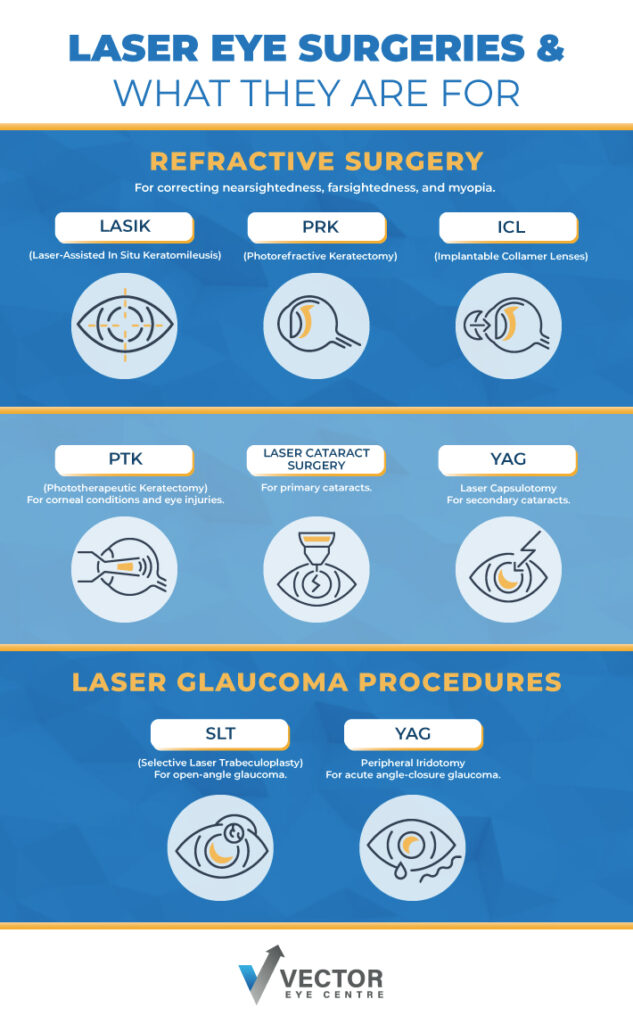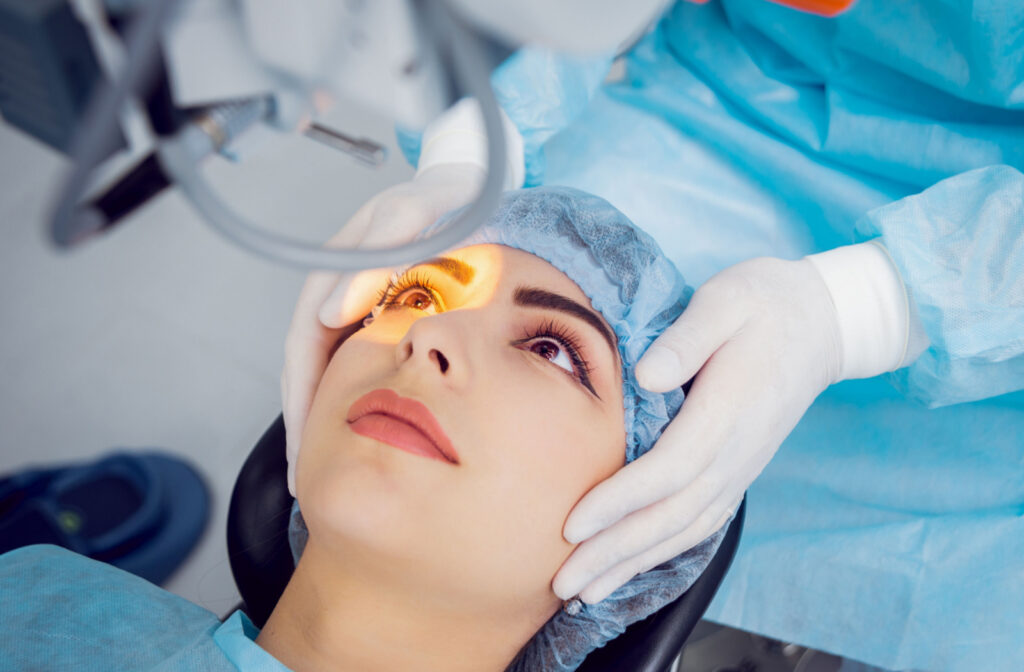For many people, the term “laser eye surgery” refers to procedures like LASIK (laser-assisted in situ keratomileusis) and PRK (photorefractive keratectomy). Those refractive surgical procedures are just 1 way lasers can be used for eye care—they are not the full extent.
The many types of refractive eye surgery include:
- Refractive surgery, such as LASIK, PRK, and ICL
- PTK (phototherapeutic keratectomy) for eye injuries, cornea scars and specific diseases
- Laser post-cataract treatments, including laser capsulotomy
- Laser glaucoma treatments, such as selective laser trabeculoplasty (SLT) and peripheral iridotomy
Lasers can go far beyond addressing vision conditions. They can assist in the treatment of cornea conditions, glaucoma, and other eye conditions. When you are referred to an ophthalmologist, we can make extensive use of a wide range of eye care technology to provide complete, thorough care for your eyes.
Refractive Laser Eye Surgery
In many cases, refractive surgery is what many people are referring to when they say “laser eye surgery.” Refractive surgeries are procedures meant to correct conditions like myopia (nearsightedness), hyperopia (farsightedness), and astigmatism.
LASIK and PRK are similar procedures—they are both based on adjusting the shape of your cornea. Procedures that use an ICL (implantable collamer lens) involve inserting new lenses into your eye. Each of these procedures can involve the use of lasers.
LASIK
LASIK is a very common procedure that is effective for most people. It can reduce or eliminate the need for glasses and contact lenses—the results can vary based on your existing eye health and vision prescription.
LASIK involves using a microkeratome blade or a femtosecond laser to create a flap in the corneal surface of your eye. That flap is folded back, and we then use an excimer laser to reshape the underlying corneal stroma and correct your vision.
PRK
PRK is often recommended as an alternative to LASIK for those who have thin corneas and those who live active lifestyles, in which there may be a risk of dislodging the flap created by LASIK.
PRK involves using a blade or laser to remove the outer layer of your cornea—the epithelium. After that is done, we use an excimer laser to reshape your cornea, much like we would with LASIK surgery.
ICL
ICLs have several names, such as implantable collamer lenses, implantable contact lenses, and phakic intraocular lenses. ICL is not a type of laser eye surgery. One of the advantages of ICL procedures is that they are reversible—which can be helpful for accommodating age-related vision changes later in life.
Dry eyes are included in potential risks shared with LASIK and PRK as well, as the low chance of halos or glares. ICLs may also come with a slightly increased risk of cataracts.
With ICL procedures, we can help address and correct refractive errors by inserting an artificial lens between your iris and natural lens. An artificial lens is selected based on your vision prescription, and an incision is made using a blade or laser to insert the lens into your eye.

Phototherapeutic Keratectomy (PTK)
PTK is similar to PRK, but instead of being used to correct your vision, it is used to correct eye injuries, remove cornea scarring and other conditions that can affect your cornea, such as recurrent corneal erosion. PTK can also be combined with corneal cross-linking (CXL) to help strengthen your cornea.
Laser Cataract Surgery
Cataract surgery is a common, safe procedure that often involves using an ultrasound device to break up a cataract. During the procedure, a laser may be used to access and remove the cataract. In some versions of laser cataract surgery, a laser may also be used to soften and help break apart a cataract before an ultrasound device is used.
When you are referred to an ophthalmologist for cataract surgery, we take the time to answer all your questions and provide all the information you need to prepare. Part of our goal to support you throughout the process is to help you learn more about cataract surgery, how to prepare, and what to expect during recovery.
YAG Laser Capsulotomy
YAG (yttrium aluminum garnet) laser capsulotomy is a procedure that may be recommended months or years after your cataract surgery. It is an in-office procedure that involves pupil dilation and takes 20–30 seconds per eye on average.
After cataract surgery, a membrane in your eye called the posterior capsule can become cloudy or wrinkled leading to a decrease in visual quality. A YAG capsulotomy can help address membrane issues so you can see clearly again.
Laser Treatments for Glaucoma
Glaucoma is a condition with many different types. In many, but not all, cases of glaucoma, eye pressure is a serious risk factor for worsening optic nerve damage and vision loss. Laser treatments can be used to help reduce pressure in your eye by increasing the flow of your aqueous humor.
There are 2 common types of glaucoma: open-angle glaucoma and acute angle-closure glaucoma. Open-angle glaucoma is a condition that typically develops gradually. It can often be treated with medication but may eventually require surgery.
Acute angle-closure glaucoma is a condition that can appear suddenly and worsen rapidly. It is considered a medical emergency, and prompt treatment is often needed to preserve your sight. A peripheral iridotomy is usually required in angle closure glaucoma.
Depending on the type of glaucoma affecting your eyes, we may recommend either selective laser trabeculoplasty (SLT) or peripheral iridotomy to help decrease your eye pressure.
Selective Laser Trabeculoplasty (SLT)
SLT procedures are used to support the drainage system in your eye, known as your trabecular meshwork, to improve the flow of aqueous humour. It is usually recommended to treat various levels and types of open-angle glaucoma.
YAG Peripheral Iridotomy
Peripheral iridotomy is a procedure that involves using a yttrium aluminum garnet laser to create a hole in your iris. The goal of this procedure is to improve the flow of aqueous humor from the front to the back of your eye.
Peripheral iridotomy is usually recommended for people experiencing acute angle-closure glaucoma. It may also be used to prevent acute angle-closure glaucoma before serious symptoms occur.

Let’s Talk About Laser Eye Surgery Together
Whether you have been referred to an ophthalmologist for refractive surgery or for treatments intended to address other eye conditions, at Vector Eye Centre, we are ready to answer all your questions and support you throughout the entire process.
Contact us to learn more about the types of laser eye surgery we can complete, the technology we use, and how we can help support your vision and eye health.



